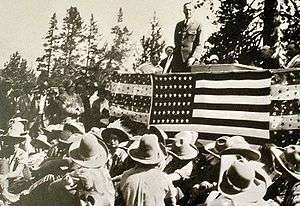Establishment of Grand Teton National Park

The establishment of Grand Teton National Park took place over a period spanning more than 50 years. Located in the northwestern region of the U.S. state of Wyoming, Grand Teton National Park is 10 miles (16 km) south of Yellowstone National Park which was established in 1872, when Wyoming, Idaho and Montana were still territories and the region was very sparsely settled.[1] By the late 19th century, conservationists were working to provide further protection to surrounding regions, leading President Grover Cleveland to create the Teton Forest Reserve, which included a portion of northern Jackson Hole.[2] By 1902, the reserve had been combined into the Yellowstone Forest Reserve, then was divided again in 1908 by President Theodore Roosevelt, establishing the Teton National Forest, which protected most of the Teton Range.[3] By 1907, the U.S. Bureau of Reclamation had constructed a temporary dam at the Snake River outlet of Jackson Lake. This dam failed in 1910 and a new concrete Jackson Lake Dam replaced it by 1911. The dam was further enlarged in 1916, raising lake waters 39 ft (12 m) as part of the Minidoka Project, designed to provide irrigation for agriculture in the state of Idaho.[4][5] Though efforts to protect the Teton Range and Jackson Hole as part of an expanded Yellowstone National Park dated back to the late 19th century, proposals to construct more dams on some of the other lakes in Jackson Hole led Yellowstone National Park superintendent Horace Albright to block such efforts. Albright was originally an advocate of the expanded Yellowstone plan which was very unpopular with local residents. By the mid-1920s local sentiment had changed as a result of proposals for a new national park including only the Teton Range and six lakes at the base of the range.[6] With the general agreement of prominent Jackson Hole residents to this plan, President Calvin Coolidge signed the executive order establishing the 96,000-acre (39,000 ha) Grand Teton National Park on February 26, 1929.[7]
The valley of Jackson Hole remained primarily in private ownership when John D. Rockefeller, Jr. and his wife visited the region in the late 1920s.[2] Horace Albright had hoped to protect the valley of Jackson Hole north of the town of Jackson from commercial exploitation. Rockefeller agreed and through a private enterprise known as the Snake River Land Company by 1927 was buying land in Jackson Hole to be later turned over to the National Park Service. In 1930 this plan was revealed to the residents of the region and was met with strong disapproval.[2] By 1942 John D. Rockefeller, Jr. became increasingly impatient that his land holdings in Jackson Hole might never be part of Grand Teton National Park, so he wrote the Secretary of the Interior Harold L. Ickes and informed him that he was considering selling the land to another party.[8] Secretary Ickes recommended to President Franklin Roosevelt that the Antiquities Act (which permitted Presidents to set aside land for protection without the approval of Congress) be used to establish a National Monument in Jackson Hole.

From property belonging to the Snake River Land Company and adding additional land from Teton National Forest, Roosevelt created the 221,000-acre (89,000 ha) Jackson Hole National Monument in 1943.[9] The monument and park were adjacent to each other and both were administered by the National Park Service, but the monument designation ensured no funding allotment, nor provided a level of resource protection equal to the park. Members of Congress repeatedly attempted to have the new National Monument abolished.[10]
After the end of World War II public sentiment shifted in favor of adding the monument to the park, and though there was still much local disagreement, the monument and park were combined in 1950.[6] In recognition of John D. Rockefeller, Jr.'s efforts to establish and then expand Grand Teton National Park, a 24,000-acre (9,700 ha) parcel of land between Grand Teton and Yellowstone National Parks was added to the National Park Service in 1972. This land and the road from the southern boundary of Grand Teton National Park to West Thumb in Yellowstone National Park was named the John D. Rockefeller, Jr. Memorial Parkway.[11] In 2001, the Rockefeller family donated the remnants of its JY Ranch for the establishment of the Laurance S. Rockefeller Preserve, dedicated on June 21, 2008.[12]
References
- ↑ "Yellowstone Fact Sheet". Plan Your Visit. National Park Service. January 10, 2012. Retrieved 2012-01-14.
- 1 2 3 Daugherty, John (July 24, 2004). "Conservationists". A Place Called Jackson Hole. Grand Teton Natural History Association. Retrieved 2012-01-14.
- ↑ "The National Forests of the United States" (pdf). Forest History Society. Retrieved 2012-01-14.
- ↑ "Jackson Lake Dam". U.S. Bureau of Reclamation. Jul 13, 2009. Retrieved 2012-01-14.
- ↑ "The Minidoka Project" (pdf). U.S. Bureau of Reclamation. 1997. Retrieved 2012-01-14.
- 1 2 Skaggs, Jackie. "Creation of Grand Teton National Park" (pdf). National Park Service. Retrieved 2012-01-14.
- ↑ Besser, Brook (March 23, 2010). Wyoming Road Trip by the Mile Marker. NightBlaze Books. p. 35. ISBN 0-9844093-0-0.
- ↑ Righter, Robert (June 1982). Crucible for Conservation: The Struggle for Grand Teton National Park. Grand Teton Natural History Association. pp. 105–106. ISBN 0-931895-54-5.
- ↑ Congressional Record. 148, Pt. 13 (September 20, 2002 to October 1, 2002 ed.). U.S. Congress. August 16, 2006. p. 17710. ISBN 0-16-076774-1.
- ↑ Righter, Robert (June 1982). Crucible for Conservation: The Struggle for Grand Teton National Park. Grand Teton Natural History Association. pp. 114–115. ISBN 0-931895-54-5.
- ↑ "John D. Rockefeller, Jr. Memorial Parkway". National Park Service. November 25, 2011. Retrieved 2012-01-14.
- ↑ Skaggs, Jackie (June 21, 2008). "Laurance S. Rockefeller Preserve Center Opens to the Public". Grand Teton National Park News Releases. Retrieved 2012-01-14.